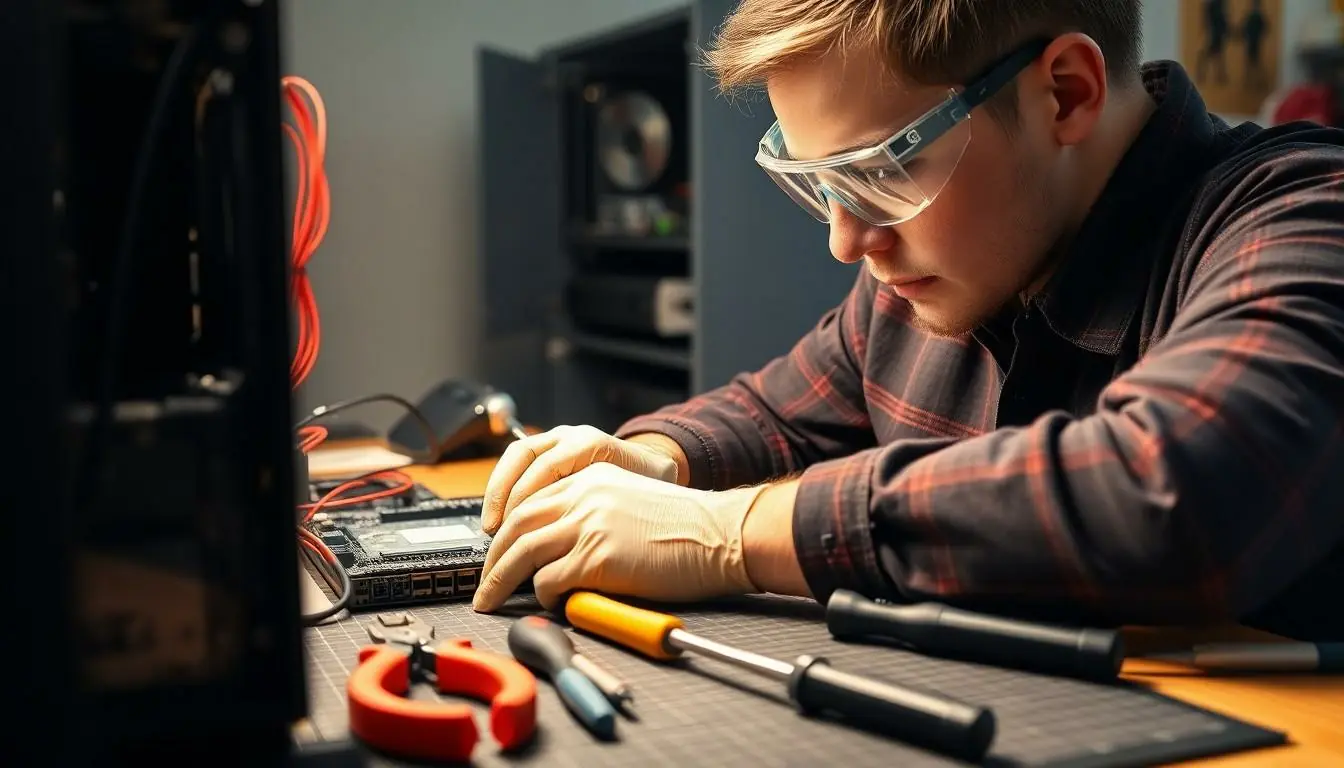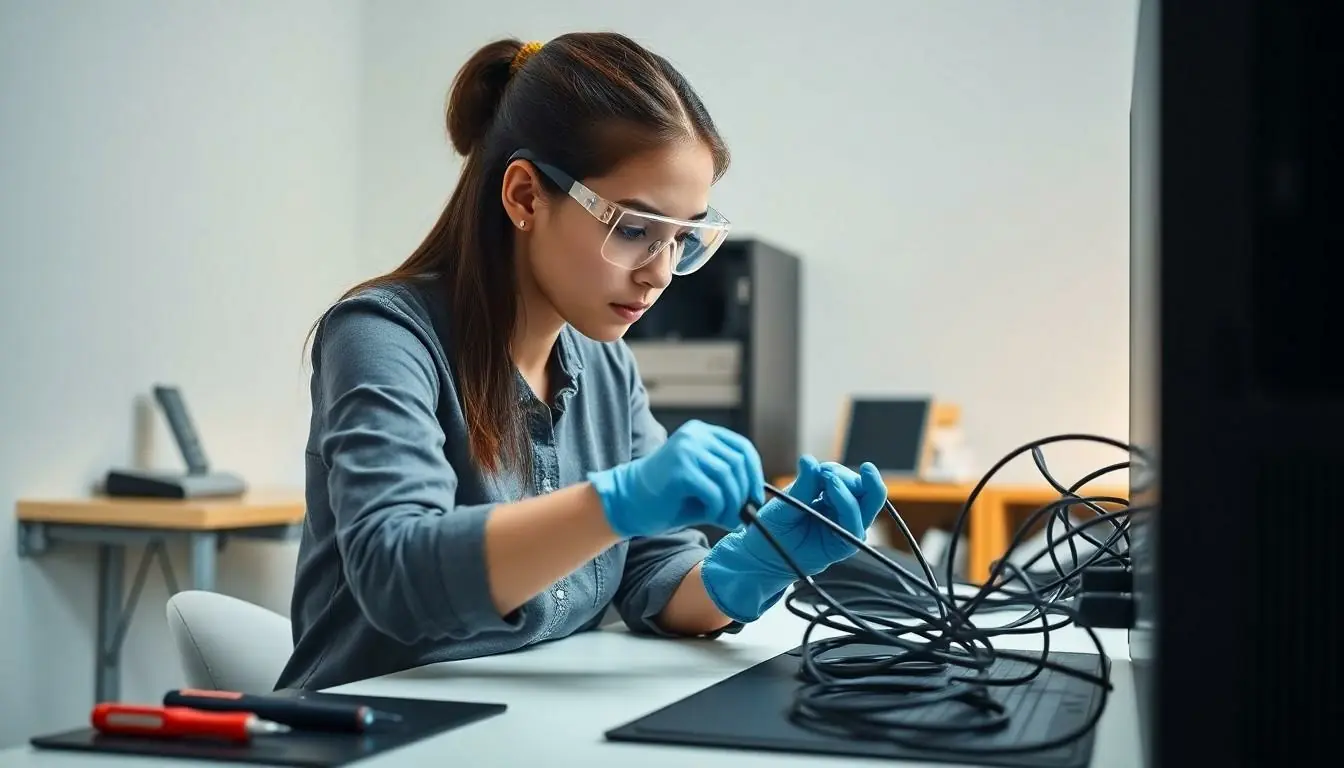Table of Contents
ToggleBefore diving into the guts of a computer system, it’s crucial to take a few essential steps. Imagine trying to fix a car without checking if it’s even in park—chaos would ensue! Similarly, working on hardware without proper precautions can lead to a shocking experience, literally.
Safety Precautions
Taking safety precautions before working on a computer system ensures a secure environment. Following these steps prevents accidents and mishaps during hardware maintenance.
Power Off the System
Powering off the system is the first step. It eliminates the risk of electrical shock and prevents damage to components. Always shut down the operating system properly through the menu, allowing it to close applications and processes. Next, wait a few moments to ensure that all internal functions cease. Ensuring that the monitor and peripherals are off reduces potential hazards. A powered-down system creates a safer workspace and allows for more comfortable handling of hardware.
Unplug All Cables
Unplugging all cables is essential for maximum safety. Disconnecting the power cord safeguards against electrical surges. This action also prepares the workstation for a thorough hardware examination. Follow through by disconnecting other associated cables, such as USB, HDMI, or audio, to avoid confusion during reassembly. Maintaining a clutter-free area is beneficial as it reduces the chance of accidental connections while working. Completing this step contributes significantly to an organized and secure hardware inspection process.
Gather Necessary Tools

Gathering necessary tools enhances efficiency and safety during hardware work. Proper preparation lays the groundwork for a successful experience.
Toolbox Essentials
Gather essential tools before tackling hardware tasks. A screwdriver set, featuring Phillips and flat-head types, proves crucial for opening cases and securing components. A pair of pliers often assists in gripping and twisting small connectors. Antistatic wrist straps prevent component damage from static electricity, ensuring safe handling. Tweezers help position tiny screws and parts with precision. Having cable ties on hand keeps the workspace organized, eliminating potential hazards.
Protective Gear
Wear protective gear to minimize risks while working on hardware. Safety goggles shield the eyes from dust and debris. Gloves, either latex or nitrile, protect the skin from sharp edges and accidental short circuits. An antistatic mat serves as a protective surface, reducing static buildup and preventing damage to sensitive components. Consider ear protection, especially in environments with loud machinery. The right protective gear fosters a safe working area and promotes successful hardware maintenance.
Review System Documentation
Reviewing system documentation is essential before engaging with hardware. It ensures familiarity with the computer’s components and specifications, protecting the system’s integrity.
User Manuals
User manuals provide critical guidance for hardware installation and maintenance. They cover setup instructions, troubleshooting steps, and safety precautions specific to the system. Familiarizing oneself with these guidelines minimizes risks and enhances efficiency. Manuals also include diagrams that visually illustrate the components’ locations. These visual aids can simplify the identification process, especially for novice users.
Hardware Specifications
Hardware specifications deliver detailed information about system components. Specifications such as memory type, processor model, and power requirements influence hardware compatibility. Knowing these details aids in selecting compatible upgrades or replacements. Manufacturers often outline these specifications in documentation, ensuring users understand their system’s capabilities. Users can avoid ordering incompatible parts by adhering to these specifications, streamlining the upgrade process.
Prepare the Workspace
Preparing the workspace is vital for safe and effective hardware work. A well-organized environment contributes to efficiency and reduces risks.
Ensure Adequate Lighting
Lighting must be bright enough to clearly see all components and tools. Poor visibility can lead to mistakes, causing damage to hardware. Utilizing natural light, when available, enhances visibility. Adding a desk lamp with adjustable brightness helps illuminate dark corners. Working in such conditions boosts accuracy in tasks like component installation or repairs.
Organize Tools and Components
Organizing tools and components minimizes time spent searching for items. Placing tools within easy reach enhances workflow and prevents distractions. Utilize trays or toolboxes to store items like screwdrivers and pliers. Labeling bins or containers for different components ensures quick identification. Keeping cables neatly managed with ties prevents tangling, promoting a safe working environment.
Taking the right precautions before working on hardware is crucial for ensuring safety and efficiency. Powering off the system and unplugging all cables are fundamental steps that prevent electrical hazards and protect components. Gathering the necessary tools and wearing protective gear further enhances safety during the process.
Additionally, reviewing system documentation is vital for understanding hardware specifications and ensuring compatibility. A well-prepared workspace, with proper lighting and organized tools, minimizes risks and promotes a smoother workflow. By following these steps, individuals can confidently engage with their computer systems while safeguarding both themselves and their equipment.






